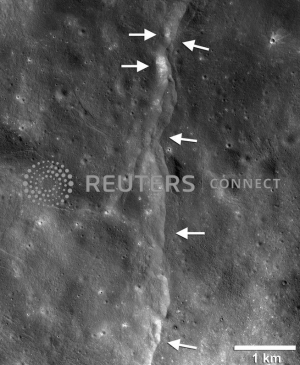|
Quakes show that moon, gradually
shrinking, is tectonically active
 Send a link to a friend
Send a link to a friend
 [May 14, 2019]
By Will Dunham [May 14, 2019]
By Will Dunham
WASHINGTON (Reuters) - The moon may be
dynamic and tectonically active like Earth - not the inert world some
scientists had believed it to be - based on a new analysis disclosed on
Monday of quakes measured by seismometers in operation on the moon from
1969 and 1977.
Researchers examining the seismic data gathered during NASA's Apollo
missions traced the location of some of the quakes to step-shaped cliffs
called scarps on the lunar surface that formed relatively recently, in
geological terms, due to the ongoing subtle shrinking of the moon as its
hot interior cools.
"It means that the moon has somehow managed to remain tectonically
active after 4.51 billion years," said Smithsonian Institution planetary
scientist Thomas Watters, who led the research published in the journal
Nature Geoscience.
Earth's tectonic activity is driven by its hot interior. The moon, which
orbits our planet at a distance of about 239,000 miles (385,000 km), has
a diameter of about 2,160 miles (3,475 km), a bit more than a quarter of
Earth's diameter.
Images from NASA's Lunar Reconnaissance Orbiter showed that the moon has
delicately shriveled as its interior has cooled over the eons, akin to a
plump grape transforming into a smaller raisin. As a result, it has
acquired thousands of small surface wrinkles in the form of surface
features called thrust fault scarps.
These faults push one part of the lunar crust up and over the adjoining
part, said University of Maryland geologist and study co-author Nicholas
Schmerr. They can reach up to about 330 feet (100 meters) tall and
extend for many miles.
"This is exciting as it wasn't clear if the moon had already gone
through this period billions of years ago and was tectonically dead, or
if it was still active in the present," Schmerr said.
U.S. astronauts placed seismometers on the lunar surface during the
Apollo 11, 12, 14, 15 and 16 missions, recording 28 shallow quakes up to
almost 5 magnitude, which is moderate strength. Eight quakes occurred
close to faults. Other events such as meteorite impacts can produce
quakes, but those would produce different seismic signatures.
[to top of second column]
|

A prominent lunar thrust fault scarp, one of thousands of such
cliffs on the moon’s landscape, discovered in Lunar Reconnaissance
Orbiter Camera (LROC) images, (left-pointing white arrows) formed
when the near-surface crust is pushed together, breaks and is thrust
upward along a fault as the Moon contracts is shown in this photo
taken August 15, 2018. NASA/GSFC/Arizona State
University/Smithsonian/Handout via REUTERS

Boulder movements and disturbed soil near the scarps also indicated
tectonic activity.
Watters said experts must be mindful that quakes may strike near
these scarps when planning sites for future lunar exploration and a
long-term human presence on the moon.

The moon is not the solar system's only object shrinking with age.
The innermost planet Mercury boasts numerous thrust faults.
(Reporting by Will Dunham; Editing by Sandra Maler)
[© 2019 Thomson Reuters. All rights
reserved.]
Copyright 2019 Reuters. All rights reserved. This material may not be published,
broadcast, rewritten or redistributed.
Thompson Reuters is solely responsible for this content. |